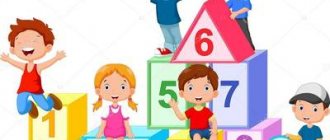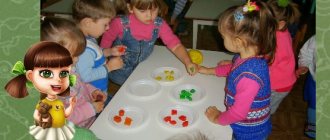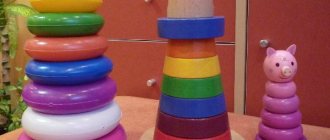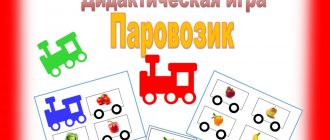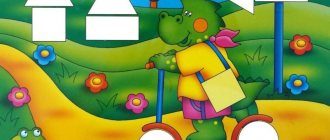Experience as a senior kindergarten teacher. Integration of FEMP in different educational areas
Integration of the formation of elementary mathematical representations (FEMP)
in different educational areas (slide 1) Mathematics is one of the most difficult subjects in school. Preschoolers don’t know about this yet and shouldn’t find out. Therefore, our task is to give the child the opportunity to feel that he can understand and master not only specific concepts, but also general patterns. And the most important thing is to know the joy of overcoming difficulties. A distinctive feature of modern pedagogy is its focus on the future. Nowadays, not only new methods of studying mathematics have appeared, but mathematics itself is a powerful factor in the development of a child, the formation of his cognitive and creative abilities. (slide 2) Integration (according to Ozhegov) - parts of one whole. The integrated approach corresponds to one of the principles of preschool didactics: education should be small in volume, but capacious.
Reforming the preschool education system in connection with the adoption (FSES DO) of the federal state educational standard for preschool education involves revising the content, methods and forms of work with children established in theory and practice. In the new conditions, it is necessary to use flexible models and technologies of the educational process, which involve the activation of independent actions of children and their creative manifestations, a humane, dialogical style of communication between the teacher and the child. (slide 3) Integrated classes are not an innovation, but a well-forgotten old and familiar, especially for experienced teachers. After all, the term “integrated” classes appeared back in 1973, but this issue was not sufficiently developed at that time. (slide 4) According to the Federal State Educational Standard for Educational Education, the program should be based on the principle of integration of educational areas: (slide) - social and communicative development, - cognitive development, - speech development, - artistic and aesthetic development, - physical development in accordance with their specifics and age possibilities of pupils. (slide 5)
(FEMP) The formation of elementary mathematical concepts in preschoolers is included in the educational area “Cognitive Development” and is aimed at obtaining primary (slide 6) ideas about the properties and relationships of objects in the surrounding world (about shape, color, size, quantity, number, part and whole, space and time). (slide 7) It is during the acquisition of mathematical concepts that the child receives a sufficiently sensory experience of orientation in the various (slide) properties of objects and the relationships between them, masters the techniques and methods of cognition, applies the knowledge and skills formed during training in practice. (slide 9) Integration of mental and physical activity can be carried out in the process of filling physical education activities with mathematical content.(slide 10) During the direct educational activities in physical education, children encounter mathematical relationships: compare an object in size and shape or determine (slide 11) where left side, and where is the right. In classes, we use various flat and three-dimensional geometric figures and numbers. (slide 12-2p) A lot of work is done on orientation in space and relative to one’s body. When consolidating quantitative calculation, students perform various exercises: (slide 13 ) “Jump on one leg”, “Jump 10 times on the left leg, 10 times on the right”, (slide 14) “Occupy a house of a certain color or shape”). Children, without realizing the load, count, reflect, think. (slide 15)
(slide 7) It is during the acquisition of mathematical concepts that the child receives a sufficiently sensory experience of orientation in the various (slide) properties of objects and the relationships between them, masters the techniques and methods of cognition, applies the knowledge and skills formed during training in practice. (slide 9) Integration of mental and physical activity can be carried out in the process of filling physical education activities with mathematical content.(slide 10) During the direct educational activities in physical education, children encounter mathematical relationships: compare an object in size and shape or determine (slide 11) where left side, and where is the right. In classes, we use various flat and three-dimensional geometric figures and numbers. (slide 12-2p) A lot of work is done on orientation in space and relative to one’s body. When consolidating quantitative calculation, students perform various exercises: (slide 13 ) “Jump on one leg”, “Jump 10 times on the left leg, 10 times on the right”, (slide 14) “Occupy a house of a certain color or shape”). Children, without realizing the load, count, reflect, think. (slide 15)
(FEMP) Formation of elementary mathematical concepts (slide 18) is directly related to the educational area “Speech development”, where the main task is the development of mathematical vocabulary in children. (slide 19 - 2p) During the integration process, children practically master lexical and grammatical categories and practice correct sound pronunciation. (slide 20) The process of forming a mathematical vocabulary involves systematic assimilation and its gradual expansion. Thus, qualitative relationships (slide 21) should be recognized in practical actions comparing aggregates and individual objects; In classes, children learn not only to recognize the size of objects, but also to correctly reflect their ideas; (slide 23) distinguish changes in total volume; find more complex orientations in the size of objects (slide 24); master nouns denoting objects, geometric figures (slide 25) as well as spatial relationships and temporal designations. (slide 26) Familiarization with literary works and small forms of folklore contributes to the child’s formation of ideas about the characteristics of various properties and relationships that exist in the natural and social world; (slide 27) this develops the child’s thinking and imagination, enriches emotions, and provides examples of the living Russian language. Many works contribute to the formation of ideas about quantitative relationships, parts of the day, days of the week, seasons, size and orientation in space. (slide 28) While reading fiction and writing short stories, we paid attention to the number of parts of a particular work. (slide 29) In any of the fairy tales, be it folk or original, there are a number of mathematical concepts. The fairy tale “Kolobok”, “Teremok”, “Turnip”, “Winter Move” and “Telephone” introduces quantitative and ordinal counting, and even the basics of arithmetic operations. (slide 30) You can also widely use such small folklore forms as proverbs, sayings, nursery rhymes, jokes, counting rhymes and, of course, riddles. (slide 31) Mathematics penetrates into “Artistic and Aesthetic Development” and helps solve problems through its methods and techniques. Visual, (slide 32) tactile landmarks will help children remember in more detail and experience certain mathematical concepts (slide 33) (slide 34) We pay attention to how many parts and what size a piece of plasticine or a strip of paper needs to be divided. (slide 35) How can you get an object of one form or another, fixing not only the color, (slide 36) shape, size of the object, but also its spatial location. (slide 37) When drawing plants, nature, (slide 38-2p) we note the location of objects, count how many parts and where, you need to depict the object (slide 39), (slide 40) (slide 41-2p) In music classes we use musically - didactic games to develop a sense of rhythm, which contribute to the development and consolidation of some mathematical definitions. Children learn that sounds can be long and short, high and low (slide 42-2p) Musical outdoor games help consolidate knowledge of the color and shape of an object. The skill of orientation in space is also strengthened.
Thus, elementary mathematical concepts in preschoolers are acquired, consolidated and developed through musical material. (slide 43) Mastering mathematical concepts continues in everyday life. While on duty, children name how many dishes are missing on the tables, how many children the tables are set for today, etc. (slide 44) During walks, the children and I noted the current day, month, season. (slide 45) We consider objects of living, inanimate nature, name the color, shape, size of an object or object. (slide 46) (Find the tallest or shortest plant on the site, etc.). In independent activities, children use “Nikitin cubes”, “Geokont”, various mosaics, puzzles, didactic games (slide 47). When introducing children to scales, we introduce (slide 48) to measuring the mass of an object. We tell you what kinds of hours there are: (slide 49-2p) (slide 50) Integration made it possible to combine together all types of activities (slide 51) of a child in kindergarten, one topic flows from one educational area to another, (slide 52-2p) and in each their teaching, reinforcing and educational tasks are solved. (slide 53) Practice shows that older preschoolers show increased cognitive interest in classes only when (slide 54) they are intrigued and amazed by something unknown to them. In this case, the information looks interesting, almost magical, in their eyes. (slide 55) The teacher’s task is to make classes on the formation of elementary mathematical concepts entertaining and unusual. (slide 56-2p) (slide 57) The age of computerization is boldly sweeping across the country, so we introduce (slide 58-2p) new technologies into our work and use multimedia equipment as visual material. (slide 59-2р) From this we can conclude that integration deeply restructures the content of education, leads to changes in working methods and creates conditions and new teaching technologies. It also provides a completely new psychological climate for the child and teacher during the learning process. (slide 60)
We recommend watching:
Preschool teacher in raising children Sample analytical report on the results of monitoring in a preschool educational institution according to the Federal State Educational Standard Analytical report on the results of diagnosing the physical development and emotional sphere of preschools Work experience of a senior kindergarten teacher in methodological work
Similar articles:
Surprising moments in kindergarten classes. Card index
Kindergarten teacher business card
Presentation of kindergarten for parents
Morning exercises in kindergarten in the preparatory group
Features of outdoor games with preschool children
